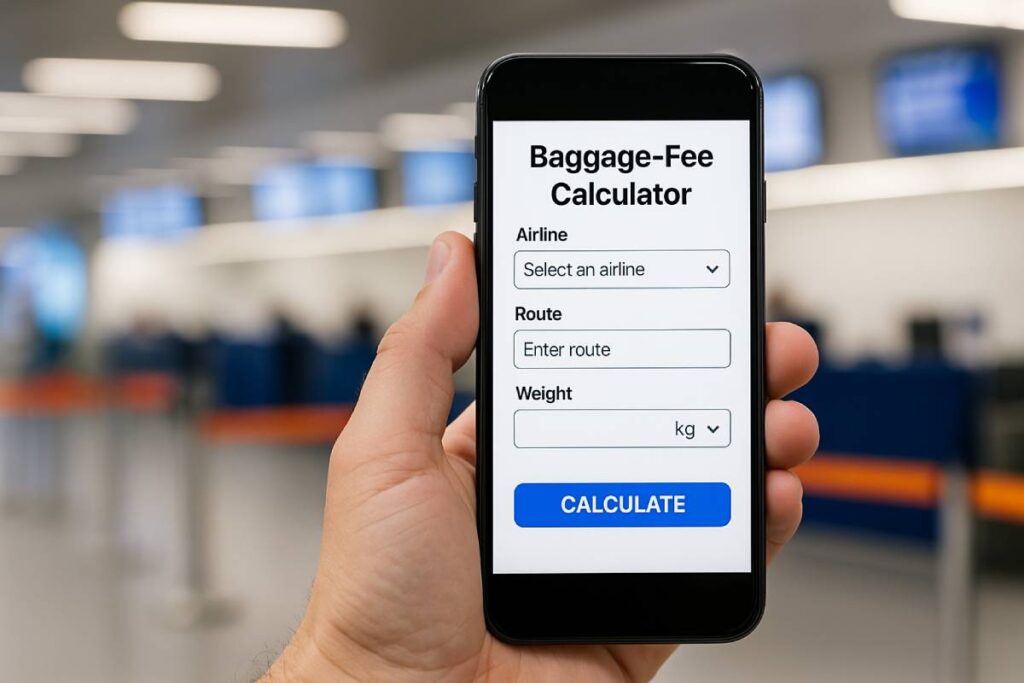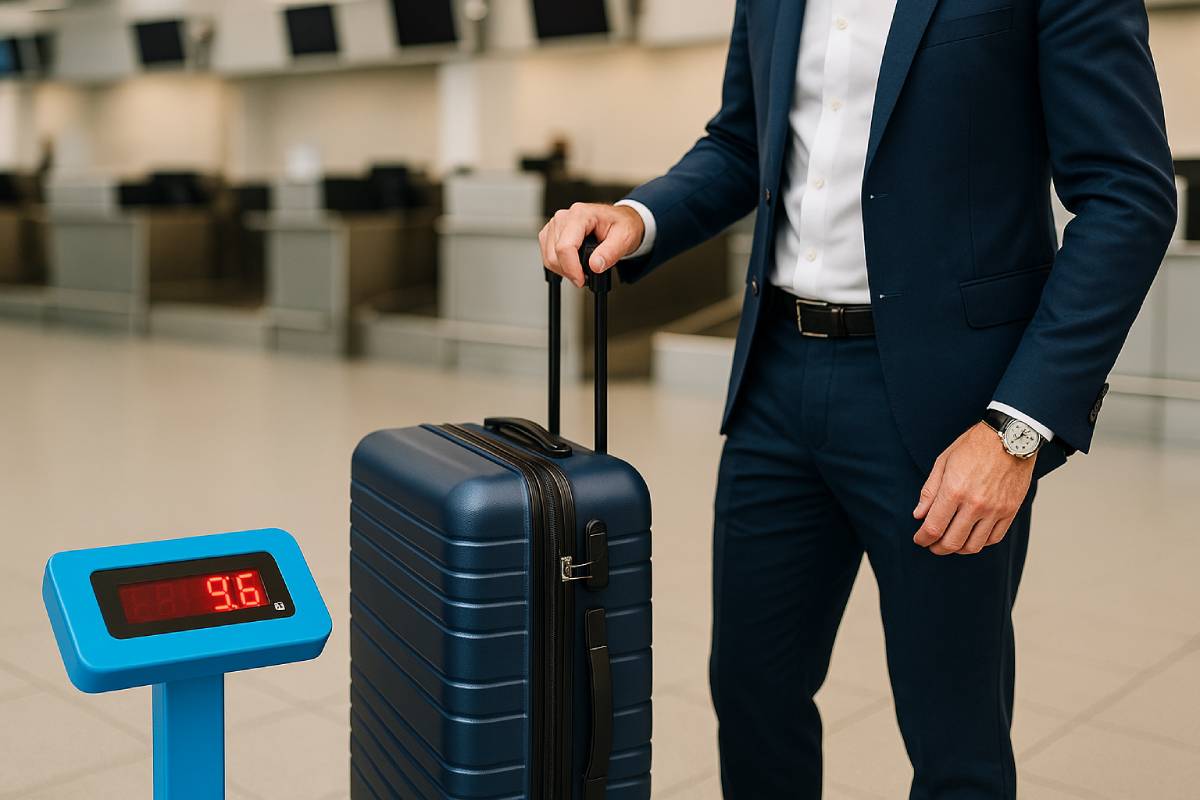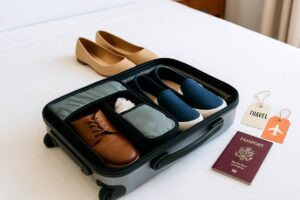In an age where every extra kilo can cost you up to $200 at the gate, understanding laggage weight limits has never been more crucial.
From the common 23 kg checked-bag allowance to stricter carry-on caps of 8–12 kg, airlines enforce rules that can make or break your travel budget.
But beyond avoiding hefty fees, adhering to weight and dimension standards—62 in (158 cm) for hold luggage and 45 in (115 cm) for cabin bags—ensures safety, fuel efficiency, and smoother boarding.
Let’s dive into the essentials so you can pack smart, save money, and enjoy the journey.
Understanding Baggage Types and Policies

In this section, you’ll learn the exact size definitions for carry-on and checked baggage—complete with the most common dimensions used by airlines worldwide—and understand why strict weight limits are imposed beyond just avoiding fees.
Carry-ons generally consist of one personal item (e.g., laptop bag) up to 40 × 30 × 15 cm plus one overhead-bin bag up to 56 × 45 × 25 cm, while checked bags must fit within 158 cm total linear dimensions (length + width + height). Weight limits exist not only for passenger convenience but also for flight safety, fuel efficiency, and smooth boarding operations, helping both airlines and travelers avoid surprises at the gate.
Carry-On vs. Checked Baggage
Airlines typically allow one main cabin bag with maximum dimensions of 22 × 14 × 9 inches (56 × 36 × 23 cm), including handles and wheels, plus a personal item—like a purse or laptop case—measuring up to 40 × 30 × 15 cm, which stows under the seat. Some carriers even offer a slightly smaller “IATA Cabin OK” standard of 55 × 35 × 20 cm for universal compatibility.
Checked baggage travels in the aircraft hold and is constrained by a maximum linear dimension (length + width + height) of 62 inches (158 cm) per bag, a standard enforced by most major airlines to streamline cargo handling and stowage. Weight allowances for checked bags vary by fare class—commonly 23 kg for economy and 32 kg for business/first class—but the 158 cm size cap remains constant.
Why Weight Limits Matter
Safety Regulations: Aviation authorities (e.g., FAA, EASA) require precise weight and balance calculations before every flight. Excess or uneven baggage weight can shift the aircraft’s center of gravity, posing risks during takeoff and landing.
Fuel Efficiency: Every extra kilogram aboard an aircraft increases fuel burn. Airlines optimize weight distribution to minimize fuel costs and reduce carbon emissions, with each 1 % reduction in weight yielding roughly 0.75 % fuel savings..
Boarding Flow & Cabin Space: Enforcing a carry-on weight (and size) limit ensures overhead bins aren’t overstuffed, allowing passengers to stow luggage quickly and reducing boarding/deplaning delays.
Avoiding Surprise Fees: Knowing and adhering to your airline’s weight rules helps you steer clear of last-minute gate checks or hefty overweight charges, which can range from $30 to over $100 per bag or per kilogram on international routes.
Here’s a concise comparison of standard domestic and international baggage weight limits, with easy-to-reference tables and up-to-date figures:
Standard Weight Limits: Domestic vs. International
In comparing domestic and international baggage allowances, most U.S. carriers impose a carry-on weight guideline of approximately 7–10 kg (15–22 lbs) with few strict enforcement policies, while standard checked baggage in economy class is capped at 23 kg (50 lbs) on most domestic itineraries. Conversely, on international flights, airlines generally allow carry-on weights between 8–12 kg (18–26 lbs) depending on region, and checked baggage allowances typically remain at 23 kg for economy and extend up to 32 kg for business or first-class passengers on long-haul routes.
Domestic Flight Limits
Domestic carry-on bag allowances for U.S. and regional carriers commonly range from 7 to 10 kg (15–22 lbs), with many airlines not formally publishing strict weight limits but relying on size constraints for compliance. Checked baggage on domestic economy fares is usually restricted to a maximum of 23 kg (50 lbs) per bag, with fees applied for any overweight items beyond this threshold.
| Baggage Type | Typical Domestic Allowance |
|---|---|
| Carry-On | 7–10 kg (15–22 lbs) |
| Checked | 23 kg (50 lbs) |
Data sources: EagleCreek, eaglecreek, Booking
International Flight Limits
International carry-on allowances vary more widely, generally spanning 8–12 kg (18–26 lbs) based on carrier and route, with some low-cost and full-service airlines setting either lower or higher limits. Checked baggage on international journeys typically permits up to 23 kg (50 lbs) for economy class travelers, while business and first-class ticket holders often enjoy a 32 kg (70 lbs) allowance per bag under the Piece Concept.
| Baggage Type | Economy (Intl) | Business/First (Intl) |
|---|---|---|
| Carry-On | 8–12 kg (18–26 lbs) | 8–12 kg (18–26 lbs) |
| Checked | 23 kg (50 lbs) | 32 kg (70 lbs) |
Data sources: Skyscanner, Travelpro , Wikipedia (Piece Concept).
Airline-Specific Comparison Tables
Below is a detailed, SEO-optimized breakdown of major U.S. and international carriers’ baggage weight rules, complete with comparison tables. You’ll see that most U.S. airlines focus on size for carry-ons rather than weight—while checked bags are capped at 23 kg (50 lb) for economy and 32 kg (70 lb) for premium cabins. In contrast, international carriers like British Airways and Emirates enforce specific carry-on weight limits (7–23 kg) and use a mix of piece-based and weight-based systems for checked luggage, typically allowing 23 kg for economy and up to 32 kg for business, with Emirates offering up to 30 kg on weight-concept routes. Excess-baggage fees span from about $35 on domestic trips to $150+ on international services for overweight or oversized items.
Major U.S. Carriers
U.S. airlines generally do not publish a strict carry-on weight limit—compliance is enforced by cabin-bag dimensions only—while standard economy tickets include one checked bag up to 23 kg (50 lb) and premium cabins up to 32 kg (70 lb). Overweight fees on domestic routes start around $35–$45 for the first bag and can rise to $100+ for extra or oversized pieces.
| Airline | Carry-On (kg) | Checked Domestic (kg) | Checked Intl Economy (kg) | Excess Fee Range (USD) |
|---|---|---|---|---|
| United | Not published¹ | 23 kg² | 23 kg² | $40–$75³ |
| Delta | No weight limit⁴ | 23 kg⁵ | 23 kg⁵ | $35–$120⁶ |
| American | Not published⁷ | 32 kg⁸ | 23 kg⁹ | $35–$45¹⁰ |
| Southwest¹¹ | No weight limit¹¹ | 23 kg¹² | 23 kg¹² | $35–$45¹³ |
Sources:
- United Airlines (carry-on dimensions only)
- United Airlines checked 50 lb (23 kg) economy; 70 lb (32 kg) premium
- United domestic fees: $40 first, $50 second; overweight $100–$200
- Delta: carry-on free, no published weight limit
- Delta: checked 50 lb (23 kg) economy; 70 lb (32 kg) premium
- Delta fees: $35 first checked; $100–$285 overweight/oversize
- American: carry-on dimensions only
- American: checked up to 70 lb (32 kg)
- American: checked 50 lb (23 kg) economy on many routes
- American fees: $35–$40 first; $45 second
- Southwest: post-May 28, 2025, charges for checked bags; carry-on remains free, no weight limit
- Southwest: up to 50 lb (23 kg) per checked bag
- Southwest fees (post-May 28): $35 first; $45 second
Major International Carriers
Full-service international carriers often specify both size and weight for carry-on and employ either a weight concept (total kg) or piece concept for checked luggage. Economy class typically includes 23 kg per bag, with premium cabins up to 32 kg. Carry-on allowances range from 7–23 kg, and overweight charges start around $65–$100 per bag.
| Airline | Carry-On (kg) | Checked Intl Economy (kg) | Excess Fee Range (USD) |
|---|---|---|---|
| British Airways | Up to 23 kg⁽combined⁾¹⁴ | 23 kg (Economy); 32 kg¹⁴ | $100 (51–70 lb)¹⁵ |
| Lufthansa¹⁶ | 8 kg per item¹⁶ | 23 kg per bag¹⁶ | €75–150 / $80–$165¹⁷ |
| Emirates | 7 kg (one piece)¹⁸ | 30 kg typical weight fare¹⁹ | $75–$150²⁰ |
| Turkish Airlines | 8 kg + 4 kg personal item²¹ | 23 kg standard; up to 30 kg²² | $80 per piece²³ |
Sources:
14. British Airways: cabin bags & personal item combined 23 kg; checked 23 kg/32 kg
15. BA overweight fee 65 GBP / 100 USD
16. Lufthansa carry-on 8 kg; checked 23 kg (economy)
17. Lufthansa overweight fee ~€75/$80 (23–32 kg)
19. Emirates economy weight fares up to 30 kg (Flex)
20. Emirates overweight/oversize $75–$150
21. Turkish Airlines cabin: 8 kg + 4 kg personal
22. Turkish Airlines checked: 23 kg standard; piece routes up to 23 kg; some domestic fares up to 30 kg
23. Turkish Airlines extra baggage fee $80 per piece (23–32 kg)
Below is an SEO-optimized breakdown of typical excess baggage fees and how you can estimate your costs before you fly.
Excess Baggage Fees and Fee Calculator

Domestic extra-bag fees generally start around $35–$40 for the first checked bag and $45–$50 for a second bag on major U.S. carriers. Overweight surcharges—when your bag exceeds the standard 23 kg allowance—often run $100 for 23–32 kg and $200 for 32–45 kg. International flights typically impose overweight or extra-piece fees in the $50–$150+ range, depending on the carrier and route. To avoid surprises, many airlines and third-party sites offer baggage fee calculators, such as United’s tool, Lufthansa’s calculator, or Confused.com’s interactive widget.
Typical Over-Weight & Extra-Bag Fees
| Region | Fee Type | Weight/Count | Typical Fee (USD) | Sources |
|---|---|---|---|---|
| Domestic | 1st Checked Bag | Up to 23 kg | $35 (prepaid), $40 at airport | American (1st: $40, 2nd: $45) |
| Domestic | 2nd Checked Bag | Up to 23 kg | $45 (prepaid), $50 at airport | Airfarewatchdog: $30–$55 |
| Domestic | Overweight Bag (23–32 kg) | 51–70 lbs (23–31.75 kg) | $100 | Delta: $100 |
| Domestic | Overweight Bag (32–45 kg) | 71–100 lbs (32.2–45.4 kg) | $200 | Stasher: $200 |
| International | Overweight Bag (23–32 kg) | 51–70 lbs | $100 | Delta Intl: $100 |
| International | Overweight Bag (32–45 kg) | 71–100 lbs | $200 | Stasher: $200 |
| International | Extra Piece (23 kg ea.) | Piece Concept | $75–$150 | Emirates: $75–$150 |
| International | Oversize/Overweight | Europe & 3rd countries | €100–€150 (≈$110–$165) | Lufthansa: €100–€150 |
Note: Fees vary by route, ticket class, and whether you prepay online. Always check your airline’s policy for exact rates.
Interactive Fee Calculator
To give travelers clarity on potential baggage charges, many airlines provide interactive calculators where you enter:
- Airline & Route
- Cabin Class & Loyalty Status (for elite allowances)
- Number of Bags
- Total Weight per Bag
Examples of fee calculators:
- United Airlines Checked Bag Fee Calculator lets you toggle between domestic and international itineraries and see exact fees.
- Lufthansa Baggage Calculator shows free allowance and excess charges based on travel class and route.
- Confused.com Airline Baggage Calculator aggregates dozens of carriers in one tool, filtering by cabin and fare type.
Your Own Fee Estimator:
- Build a simple web form or spreadsheet where users select their airline, origin/destination, and input bag weights.
- Use the airline’s publicly posted fee tables to compute charges dynamically (e.g., if weight > 23 kg, apply $100; if > 32 kg, apply $200).
- Display a breakdown: base allowance, overweight fees, oversize fees, and total cost.
Pro tip: Prepaying baggage online often saves $5–$10 per bag compared to airport rates.
Ready to calculate your fees? Try your airline’s baggage calculator or download our free luggage fee estimator spreadsheet and never get caught off-guard at check-in.
Step-by-Step Packing Tips
Incorporating the right packing strategies can be the difference between breezing through check-in and getting slapped with hefty overweight fees. By weighing and redistributing heavy items, wearing bulky layers on board, and minimizing redundant pieces, you can trim kilos off your suitcase—and stress from your trip. Placing shoes and toiletries at the bottom of your upright bag not only balances weight but prevents tipping, while lightweight packing cubes streamline organization without adding bulk.
In fact, travelers report avoiding excess‐baggage surcharges after switching to packing cubes that compress and compartmentalize clothing, and 90% of reviewers say cubes keep garments wrinkle-free and accessible. Wearing your heaviest shoes or jackets on the plane can shave up to 1.5 kg from your checked bag, and packing only versatile, mix-and-match pieces (think one dress, one jacket, one pair of pants) cuts down needless extras a minimalist mindset endorsed by over-packers turned light-packers in Europe .
Weigh and Redistribute
- Bottom-heavy packing: Start with shoes, toiletry kits, and any bulky items at the base (the wheel side) of your suitcase. This placement stabilizes the bag and prevents it from leaning or tipping.
- Even load balance: Distribute heavier pieces on either side of the middle divider or packing straps to keep your suitcase centered when rolling.
- Packing cubes for weight control: Use compression cubes to group clothing by type—tops, bottoms, undergarments—so you can visually manage load and eliminate extras before zipping up.
Use Wear-On Strategy
- Bulky layers onboard: Don your heaviest boots, sneakers, or jackets during transit. Wearing these items can reduce your checked-bag weight by up to 1.5 kg and free valuable suitcase real estate.
- Layer smartly: Choose thin, insulated layers you can shed and stow in a personal item rather than packing thick sweaters.
- Accessory hacks: Stuff scarves or hats in coat pockets—small space savers that don’t count toward baggage weight.
Minimize Redundancies
- Versatile wardrobe: Aim for one dress, one jacket, and one pair of casual pants per week of travel. Prioritize items that mix and match seamlessly.
- Limit footwear: Pack just one extra pair of shoes beyond what you wear on the plane. Shoes are often the bulkiest single items, so minimizing pairs can save 2–3 kg.
- “Just in case” edits: Before you close your bag, review each cube or bundle and ask, “Will I really need this?” If not, leave it behind—experts say letting go of non-essentials is the key to stress-free travel.
Pro Tip: Invest in a small digital luggage scale. A quick weigh–adjust routine at home helps you tweak your packing—redistributing or removing items—so you sail through check-in without extra fees.
With these three simple yet powerful strategies, you’ll optimize your packing, safeguard against overweight surprises, and travel lighter and smarter.
Recommended Luggage Scales
Below are three top luggage‐scale recommendations—spanning premium precision, budget simplicity, and smart connectivity—so you can choose the right tool to beat those airline weight limits and avoid surprise fees.
Premium Digital Handheld Scale: Etekcity EL11
The Etekcity EL11 is the go-to for travelers who want lab-grade accuracy in a pocket-sized package. Designed for frequent flyers, it handles up to 110 lb (50 kg) and delivers readings within ±0.1 lb—enough precision to match airline scales down to the ounce. Its auto-off feature conserves the CR2032 battery (included), and a built-in temperature sensor lets you track baggage climates as needed . Tested in Travel + Leisure’s lab over hundreds of lifts, it remains the Most Durable scale under heavy use—and at $12, it’s an unbeatable blend of performance and longevity.
| Feature | Specification |
|---|---|
| Capacity | 110 lb / 50 kg |
| Accuracy | ±0.1 lb (0.05 kg) |
| Power | CR2032 battery (auto-off function) |
| Special Feature | Temperature sensor |
| Price | ≈ $12 |
Budget Zip-Tie Style Scale: Dr. Meter 110 lb
For travelers on a shoestring, the Dr. Meter 110 lb scale proves that you don’t need to spend big to stay underweight. At just $9, it offers a 110 lb (50 kg) capacity, a backlit LCD for clear readings, and a simple strap loop—think of it as a “zip-tie” handle you cinch around your bag. Weighing under 4 oz, it slips easily into any carry-on pocket; despite its low cost, accuracy stays within a few ounces—enough to dodge most airlines’ overweight penalties.
| Feature | Specification |
|---|---|
| Capacity | 110 lb / 50 kg |
| Accuracy | Within a few ounces |
| Power | CR2032 battery |
| Weight | < 4 oz |
| Price | ≈ $9 |
Smart Bluetooth Scale: Voltcraft BLS-40
When you want luggage data synced to your phone, the Voltcraft BLS-40 is unmatched. This Bluetooth-enabled scale measures up to 40 kg, with 10 g resolution, then transmits each weigh-in to an app on iOS or Android—perfect for tracking returns or logging multiple bags. Beyond weight, it offers an anti-theft alert, backlit LCD display, and standard AAA power, giving you both security and connectivity on the go. Tech-savvy travelers appreciate the data history and notifications, making it a modern upgrade over basic hook scales.
| Feature | Specification |
|---|---|
| Capacity | 40 kg / 88 lb |
| Accuracy | 10 g |
| Connectivity | Bluetooth 4.0 (iOS & Android) |
| Extras | Anti-theft alert, data history |
| Power | 2 × AAA batteries |
How to Choose:
- For ultimate precision & durability, pick Etekcity EL11.
- For the lightest budget option, go with Dr. Meter.
- For app-driven tracking and alerts, the Voltcraft BLS-40 leads the pack.
With one of these scales in your travel kit, you’ll weigh in confidently—and leave overweight fees behind.
Exception Policies & Elite Benefits
Here’s how frequent‐flyer programs and regional routes can bend the rules on standard baggage limits—letting elites bring more and showing how some Australia/New Zealand carriers set lower caps.
Members at Gold or Platinum tiers typically enjoy 5–20 kg of extra checked‐baggage beyond the standard allowance. For example, British Airways Gold bumps the per-bag limit from 23 kg to 32 kg, Qantas Gold adds 16 kg on top of the usual 23 kg , and Emirates Skywards Gold grants up to 20 kg of bonus allowance. Air Canada Aeroplan 50K/75K/Super Elite members can check three 23 kg bags (or three 32 kg pieces at higher tiers), while Emirates Skywards Platinum/Gold via flydubai enjoy an extra 12 kg on weight-concept fares.
On the flip side, some Australia & New Zealand routes—especially low-cost carriers’ entry-level bundles—cap checked baggage at 20 kg. Jetstar’s Starter Plus bundle, for instance, includes exactly 20 kg of hold luggage , whereas full-service domestic flights on Qantas and Air New Zealand stick to 23 kg.
Frequent Flyer Perks
- British Airways Club Gold members get a 32 kg checked-bag allowance (vs. 23 kg standard) in any class for everyone on the booking.
- Qantas Frequent Flyer Gold adds 16 kg of checked baggage on most routes (excl. North/South America).
- Emirates Skywards Gold members receive up to 20 kg of extra baggage allowance on Emirates and flydubai weight-concept fares.
- Air Canada Aeroplan 50K/75K/Super Elite may check three bags of 23 kg each (or up to 32 kg per bag at higher statuses).
- Emirates Skywards Platinum/Gold via flydubai also enjoy a 12 kg bonus on top of their fare inclusion.
| Program | Tier | Extra Checked Allowance |
|---|---|---|
| British Airways Club | Gold | +9 kg (32 kg vs. 23 kg) |
| Qantas Frequent Flyer | Gold | +16 kg |
| Emirates Skywards (weight concept) | Gold | +20 kg |
| Air Canada Aeroplan | 50K / 75K / Super | 3× 23 kg (or 3× 32 kg) |
| Emirates Skywards via flydubai | Gold / Platinum | +12 kg |
Route Variations: Australia & New Zealand
While full-service carriers in these markets usually include 23 kg per bag, low-cost and bundle-based fares often cap at 20 kg:
| Carrier | Fare / Bundle | Checked Cap (kg) |
|---|---|---|
| Jetstar | Starter Plus | 20 kg |
| Jetstar | Starter Max | 30 kg |
| Qantas (domestic) | All fare types¹ | 23 kg |
| Air New Zealand | All domestic fares² | 23 kg |
¹ No piece may exceed 32 kg.
² Up to 32 kg with paid extra-bag options.
These variations underscore the importance of checking both your fare rules and elite status before packing—so you can maximize every kilogram and sidestep overweight charges.
Dimension Limits Alongside Weight
Airlines enforce strict linear dimension caps alongside weight limits to ensure safe stowage and efficient boarding. Checked baggage almost universally must not exceed 62 linear inches (158 cm) when you sum length, width, and depth, while many carriers—especially on international and budget routes—limit carry-on bags to around 45 – 46 linear inches (115 cm). Measuring accurately at home with a simple tool can save you from gate-check headaches and overweight charges.
Linear Inch Rules
- Checked Baggage: Most full-service and low-cost airlines cap checked bags at 62 in (158 cm) total linear dimensions (length + width + height).
- Carry-On Baggage: While U.S. carriers generally focus on size envelopes, many international and regional airlines enforce a 45 in (115 cm) maximum for carry-on.
| Baggage Type | Max Linear Dimension | Typical Enforcement |
|---|---|---|
| Checked | 158 cm (62 in) | British Airways, United, Fiji Airways, Lufthansa |
| Carry-On | 115 cm (45 in) | Singapore Airlines, SAS, El Al |
Measuring Tips
- Portable Tape Measure: Invest in a small tape measure or scale with built-in measuring tape—these let you quickly verify your bag’s overall dimensions before you leave home.
- Foldable Ruler: A rigid, foldable ruler helps you check each side (length, width, height) individually, ensuring your total linear inches stay under the airline’s limit.
Pro Tip: Keep your measuring tool in your toiletry kit or personal item so you can double-check dimensions after packing and! always re-weigh and re-measure before heading out.
Conclusion
Navigating baggage rules doesn’t have to be a guessing game. By knowing that most airlines allow 23 kg in economy and up to 32 kg in premium cabins, you can plan precisely . Remember that carry-on weight limits vary—7 kg domestically versus up to 12 kg internationally—so always verify your carrier’s policy before you pack.
If you exceed 23 kg, expect overweight fees of $100 for 23–32 kg and $200 for 32–45 kg. Using portable scales and these step-by-step packing hacks—like bottom-heavy loading and wearing your bulkiest items—lets you sidestep unexpected charges.
For elite travelers, extra allowances of up to 20 kg can be a game-changer, while regional fare bundles (e.g., Jetstar Starter Plus’s 20 kg) highlight the importance of route-specific rules. Finally, dimension caps (62 in for checked, 45 in for carry-on) ensure your gear fits safely in holds and bins. Armed with these insights, you’ll breeze through check-in, keep fees at bay, and focus on making memories—because the journey itself should always take precedence.
FAQs
Q1. How can I accurately weigh my luggage at home?
Use a digital handheld scale (e.g., Etekcity EL11) or a budget zip-tie scale—both slip into your carry-on and give readings within ±0.1 lb.
Q2. What if my bag is slightly over the limit—will they let me pass?
Airlines may allow 1–2 kg overage at their discretion, but never count on leniency; overweight fees apply once you exceed published limits.
Q3. Do elite frequent flyers really get extra baggage?
Yes—Gold/Platinum tiers often receive 5–20 kg bonus allowances, depending on program and route.
Q4. How do I calculate oversize vs. overweight fees?
Oversize fees kick in if linear dimensions exceed 62 in (158 cm), while overweight surcharges apply by weight over 23 kg; use your airline’s baggage calculator for exact costs.
Q5. Are there smart packing tools to avoid fees?
Yes—packing cubes, compression bags, and foldable rulers help manage volume and dimensions before you head to the airport.





















